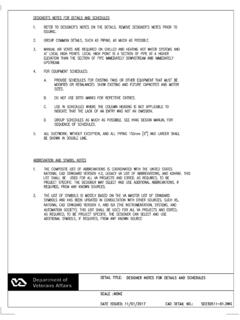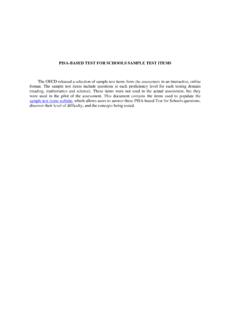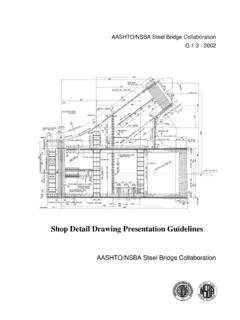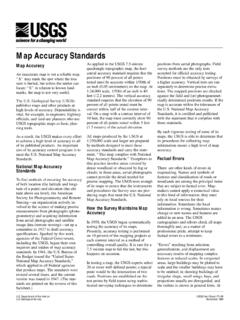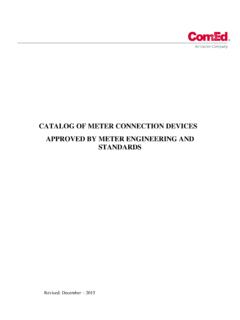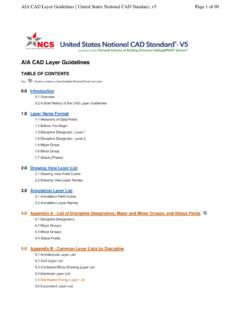Transcription of Production Part Approval Process (PPAP) Assessment
1 ppap Assessment Page 1 of 15. Production part Approval Process ( ppap ). Assessment ppap Submission Assessment The following general criteria and element specific are developed to drive detail for robust submissions and Assessment . Also reference APQP Activities and minimum submission elements for all A Risk, B risk and other identified components. 1. Is there evidence of APQP execution? 2. Is there evidence of supplier team engagement? 3. Is there evidence of Organization team engagement? 4. Are all documents controlled? 5. Is the submission to ppap 4th edition requirements? 6. Is there clear and proper detail provided on Reason for Submission ? 7. Was proper submission level agreed upon prior to submission? 8. If Level 2 or 4 submissions shall clearly document elements being submitted. 9. Is there evidence of prior agreement for submission requirements? 10. In case of re-submissions, is it identified the reason for resubmission, previous gaps, corrective action taken and updated results provided?
2 11. Are all documents legible and understandable? 12. Are all submission subcomponents/processes included? 13. Does the ppap exhibit proper detail and compliance? 14. Was the ppap submitted on time? Design Record Complete drawing(s) for both purchased level and all components. Characteristics Library or fully ballooned drawing including all Dimensions, Characteristics, Specification, Attributes, Customer Specific Requirements, Released drawing at ppap level requirement. Special Characteristics identified. A note stating access to controlled current drawing(s) and specification is available through REDI, Workflow, EPIX, ETC. 1. Is a copy of the drawing included that support the part or assembly both Organization and supplier drawing? 2. Is a list of specification supporting the Production of this part provided? 3. Is change level verification assured or available that the supplier has the latest revisions of specification? 4. Is the form of dimension throughout the ppap identical in all documentation, (metric /.)
3 English). 5. Is the form of reporting dimensions throughout the ppap per Organization drawing? 6. Have dimensions that affect fit, function and durability been identified? 7. Are reference dimensions identified to minimize inspection layout time? 8. Are sufficient control points and datum surfaces identified to design functional gages? ppap Assessment Page 2 of 15. 9. Are tolerances compatible with accepted manufacturing standards? 10. Are there any requirements specified that can't be evaluated using known inspection techniques? Authorized Engineering Change Documents Authorized engineering change documents for those changes not yet recorded in the design record but incorporated in the product, part or tooling. Submissions shall include written and approved Deviation authorization for anything that varies from the Design Record. 1. If applicable is approved deviation attached? 2. Is deviation completely filled out? 3. Are proper approvals in place? 4. Does deviation clearly identify number of pieces, time limit, change forthcoming, ETC.
4 Information for proper ppap disposition? Customer Engineering Approval Organization requires formal engineering Approval unless engineering waiver documented and in place. Include any supporting documentation that formalizes Organization's consent to the design ( application checklist, functional specification, etc.) Include Internal (suppliers). documents that re-interpret Design Records, including Process Instruction sheets used to communication the Design Record data throughout the Process . (see Control Plan and addendum for Process Instructions). 1. Formal controlled document for Customer Engineering Approval . 2. Formal controlled document of engineering waiver. Design Failure Mode and Effects Analysis (design responsible organization). Design FMEA. A single Design FMEA may be applied to a family of similar parts or materials. All characteristics must be addressed. Highest risk must be addressed. There shall be a current detailed Design FMEA in place for each component or family of components.
5 1. The supplier shall attach the Design FMEA of saleable part number and components. 2. Other design FMEAs shall be attached to fully cascade the product a. Product Vehicle b. System / Group Level c. Assembly Level d. Component Level 3. Does the FMEA drive Design Improvements as primary objective? 4. If proprietary, is statement attached that DFMEA is available at supplier or to be presented at Organization upon request? 5. Does FMEA address all high-risk Failure Modes, as identified by the FMEA team, with executable Action Plans? 6. Does Analysis/Development/Validation (A/D/V) and/or Design Verification Plan and Report (DVP&R) consider the failure modes from the Design FMEA? ppap Assessment Page 3 of 15. 7. Does FMEA scope include integration and interface failure modes in both block diagram and analysis? 8. Does FMEA consider all major lessons learned (such as high warranty, campaigns, etc.). as input to failure mode identification? 9. Does FMEA identify appropriate Special Characteristics candidates, as input to the Special Characteristics selection Process ?
6 10. Were similar part FMEA's considered? 11. Were personnel from all support groups as well as manufacturing included in preparing the FMEA? 12. Have customer reliability/warranty data been utilized in preparing FMEA? 13. Is there evidence that the FMEA is a living document? 14. Have customer product problems and/or rejections been included, with counter measures? 15. Have appropriate counter measures been planned or taken for high-risk numbers? 16. Is the FMEA data being used in continuous quality improvement programs? 17. Is the individual responsible for the improvement and/or corrective action identified? 18. Were customer plant problems used as an aid in developing the FMEA? 16. Have the causes been described in terms of something that can be fixed or controlled? 17. Are the criteria used to determine Special Characteristics documented? 18. Were the appropriate personnel involved in determining the Special Characteristics? 19. Has all dimensional tolerances and material properties been considered?
7 20. Was the design FMEA utilized to determine the Special Characteristics? 21. Have Special Characteristics been identified for all products? 22. Has warranty and reliability data been included to determine the characteristics? 23. Is there evidence that all known Special Characteristics were included? 24. Were attribute characteristics included? 25. Are New Product Introductions and design changes included in identifying Special Characteristics? 26. Is there clear linkage to PFMEA and other APQP documents? 27. Does submission include action list from Design Review? 28. Are similar or historical DFMEAs attached? 29. Is historical campaign and warranty data attached? 30. Is objective evidence from VOC cascaded throughout QFD? List of Special Characteristics from Supplier Design responsible All Special Characteristics must be addressed. Supplier recommended Special Characteristics. 1. If applicable, are all the Special Required Characteristics identified and listed?
8 2. Are the Special Design Characteristics identified and listed? 3. Are the Special Process Characteristics identified and listed? 4. Was Supplier design to above criteria? Process Flow Diagram Assessment Process Flow Diagram is a representation of the Process flow.. Diagram accurately reflects Process , rework, and inspection. All stations shall be identified that create Required, Design and Process Characteristics and shall match ppap Assessment Page 4 of 15. with the Design Record, FMEAs, Control Plan, Work Instructions and ALL APQP. documentation. Process flow diagrams for families of similar parts are acceptable if the new parts have been added and Process flow revised. Each distinct manufacturing Process shall have a Process Flow Chart. The flow chart shall be a schematic representation of the current or proposed Process flow. All rough, intermediate, and finishing operations shall be included as well material handling techniques, inspection steps and sub-contracted products and processes.
9 Additionally, the flow shall demonstrate cleaning, packaging and other logistics steps until the customer consumes product. Alternate and/or backup processes shall be documented. 1. Process Flow Chart must be in place, which identifies all manufacturing operations, handling techniques, inspection steps, alternate/back-up processes and sub-contract suppliers. 2. Method of handling rework and scrap shall be clearly illustrated. 3. Process layout shall reflect planning so that a logical flow of material can occur during manufacturing of the product. 4. Does the flow chart illustrate the sequence of Production ? 5. Does the flow chart start with and detail the actual beginning of Process (including purchased material and processes) and movement of material throughout all manufacturing operations? 6. Has the pull system/optimization been considered for this Process ? 7. Is the Process flow chart controlled, updated and reviewed for completeness? 8. Does the flow chart include all assembly and packaging operations?
10 9. Are the sequences identified (operation or sequence number) so as to follow through to other APQP requirements? 10. Were all appropriate FMEA's available and used as aids to develop the Process flow chart? Are inspection/quality assurance steps, data recording, attribute checks and/or functional testing included for each Process step? 11. Does the flow chart indicating the material flow and control for handling rework and scrap? 12. Does the material flow consider potential quality problems due to handling and sub- contracted operations? 13. Does the flow chart illustrate shipment to the customer and steps to consumption? 14. Does the flow chart describe how the product will move, roller conveyor, slide containers, tubs, etc? 15. Are steps in the Process where product is stored and/or staged clearly identified? 16. Does the flow chart illustrate special handling requirements (green pre-heat, post grind, assembly)? 17. Does the flow chart identify in detail all in-house alternate or back-up processes?


